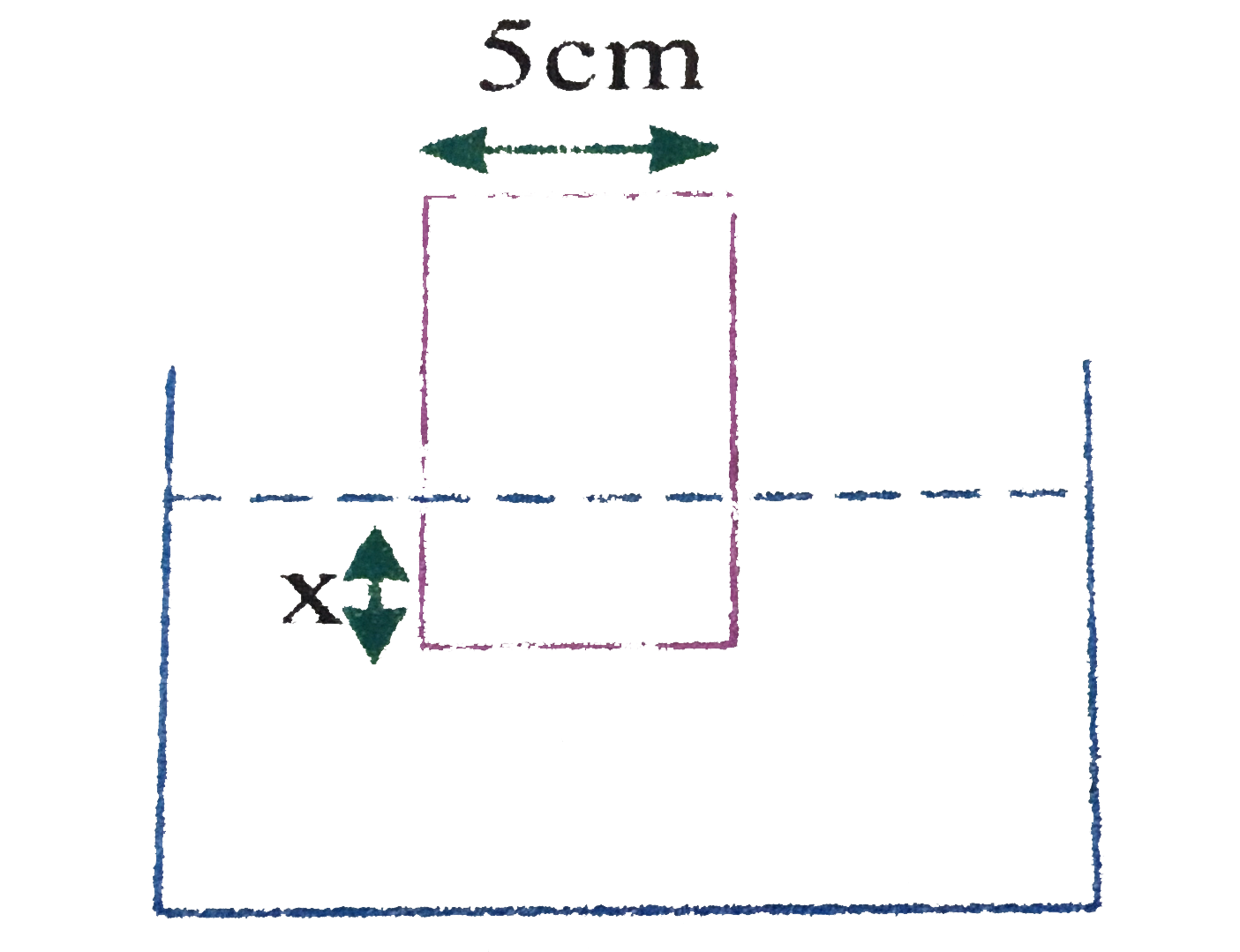A cubical block of iron 5 cm on each side is floating on mercury in a vessel. (i) what is the height of the block above mercury level ?
(ii) Water is poured in the vessel unitl it just covers the iron block. What is the height of water column . density of mercur 13.6gm/cm3. Density of iron 7.2 gm/cm3
To solve the problem step by step, we will break it down into two parts as outlined in the question.
Part (i): Height of the block above mercury level
1. Determine the volume of the iron block:
The block is cubical with each side measuring 5 cm.
Volume of the block=side3=5cm×5cm×5cm=125cm3
2. Calculate the weight of the iron block:
The density of iron is given as 7.2 g/cm³.
Weight of the block (mg)=Volume×Density×g=125cm3×7.2g/cm3×g=900g×g
3. Apply Archimedes' principle:
The weight of the block is equal to the upthrust (buoyant force) acting on it. The upthrust is given by the volume of the block submerged in mercury multiplied by the density of mercury.
Upthrust=Volume submerged×Density of mercury×g
Let Vs be the submerged volume. The total volume of the block is 125 cm³, so:
Vs=125cm3−Vabove
where Vabove is the volume of the block above the mercury level.
4. Set up the equation:
Weight of the block=Upthrust
900g=(125−Vabove)×13.6g
5. Solve for Vabove:
900=(125−Vabove)×13.6
Dividing both sides by 13.6:
90013.6=125−Vabove
66.18=125−Vabove
Rearranging gives:
Vabove=125−66.18=58.82cm3
6. Calculate the height above mercury:
The volume of the block above the mercury can be converted to height:
Vabove=Base area×Height above mercury
The base area of the cube is 5×5=25cm2:
58.82=25×h
Solving for h:
h=58.8225≈2.35cm
Part (ii): Height of the water column
1. Set up the forces:
When water is poured until it just covers the iron block, we have two forces acting upwards: one from the mercury and one from the water. The total upthrust must equal the weight of the block.
2. Define variables:
Let y be the height of the water column. The height of the mercury column above the block will then be 5−y.
3. Write the equation for equilibrium:
Weight of the block=Upthrust from mercury+Upthrust from water
900=(5−y)×13.6+y×1
4. Simplify the equation:
900=(5×13.6−13.6y)+y
900=68−12.6y
Rearranging gives:
12.6y=68−900
12.6y=−832
y=−83212.6≈2.53cm
Final Answers:
(i) The height of the block above mercury level is approximately 2.35 cm.
(ii) The height of the water column is approximately 2.53 cm.
The block is cubical with each side measuring 5 cm.
Volume of the block=side3=5cm×5cm×5cm=125cm3
The density of iron is given as 7.2 g/cm³.
Weight of the block (mg)=Volume×Density×g=125cm3×7.2g/cm3×g=900g×g
The weight of the block is equal to the upthrust (buoyant force) acting on it. The upthrust is given by the volume of the block submerged in mercury multiplied by the density of mercury.
Upthrust=Volume submerged×Density of mercury×g
Let Vs be the submerged volume. The total volume of the block is 125 cm³, so:
Vs=125cm3−Vabove
where Vabove is the volume of the block above the mercury level.
Weight of the block=Upthrust
900g=(125−Vabove)×13.6g
900=(125−Vabove)×13.6
Dividing both sides by 13.6:
90013.6=125−Vabove
66.18=125−Vabove
Rearranging gives:
Vabove=125−66.18=58.82cm3
The volume of the block above the mercury can be converted to height:
Vabove=Base area×Height above mercury
The base area of the cube is 5×5=25cm2:
58.82=25×h
Solving for h:
h=58.8225≈2.35cm
When water is poured until it just covers the iron block, we have two forces acting upwards: one from the mercury and one from the water. The total upthrust must equal the weight of the block.
Let y be the height of the water column. The height of the mercury column above the block will then be 5−y.
Weight of the block=Upthrust from mercury+Upthrust from water
900=(5−y)×13.6+y×1
900=(5×13.6−13.6y)+y
900=68−12.6y
Rearranging gives:
12.6y=68−900
12.6y=−832
y=−83212.6≈2.53cm
(i) The height of the block above mercury level is approximately 2.35 cm.
(ii) The height of the water column is approximately 2.53 cm.
Topper's Solved these Questions
- FLUID MECHANICSBOOK - PHYSICS GALAXY - ASHISH ARORACHAPTER - FLUID MECHANICSEXERCISE - practice Exercise 7.1
10 Videos
- FLUID MECHANICSBOOK - PHYSICS GALAXY - ASHISH ARORACHAPTER - FLUID MECHANICSEXERCISE - Practice Exercise 7.2
8 Videos
- GRAVITATIONBOOK - PHYSICS GALAXY - ASHISH ARORACHAPTER - GRAVITATIONEXERCISE - Unsolved Numerical
94 Videos
Similar Questions
Knowledge Check
A cubical block of steel of each side equal to 1 is floating on mercury in vessel. The densities of steel and mercury are ρs and ρm. The height of the block above the mercury level is given by
Al(1+ρsρm)Bl(1−ρsρm)Cl(1+ρmρs)Dl(1−ρmρs)A cubical block of copper of side 10cm is floating in a vessel containing mercury. Water is poured into the vessel so that the copper block just gets submerged. The height of water column is
(ρHg=13.6g/cc,ρCu=7.3g/cc,ρwater=1gm/cc)A1.25 cmB2.5cmC5cmD7.5cm
The height of mercury which exerts the same pressure as 20 cm of water column, is
View SolutionIf the mercury in the barometer is replaced by water what will be the resulting height of the water column?
Density of water =1000kgm−3 density of mercury =13600kgm−3
View SolutionAt a given place is barometer records a pressure of 70 cm of mercury. If the mercury in the barometer is replaced by water, what would be the height of the water column? Take density of mercury =13600kg/m3 density of water =1000kg/m3
View SolutionA cubical metal block of edge 12 cm floats in mercry with one fifth of the height inside the mercury. Water poured till the surface of the block is just immersed in it. Find the height of the block is just immersed in it. Find the height of the water column to be poured. Specific gravity of mercury =13.6.
View SolutionIf the mercury in the barometer is replaced by water, what will be the resulting height of the water column? Density of water =1000kgm−3 density of mercury =13600kgm−3
View SolutionCalculate the height of a column of water equivalent to 1 atmosphere. (density of Hg =13.6gcm−3)
View Solution

